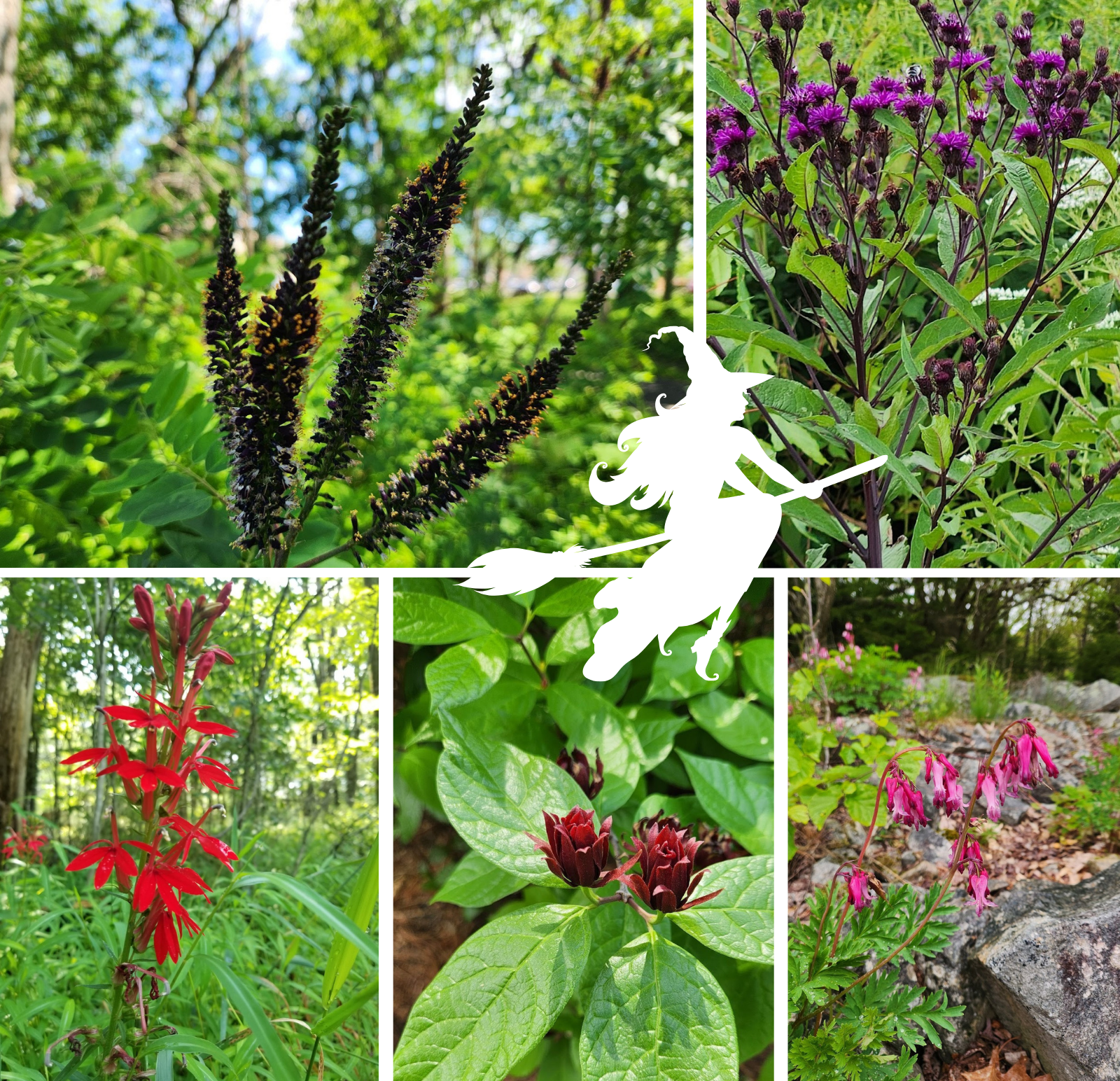Not all gardens have to have a cheery, bright aesthetic. If you prefer the macabre to the mainstream, here are five combinations of native plants to give your backyard a witchy, goth look.
The Vision
To achieve this look, I’m pulling plants for a few different reasons:
- Rich reds and purples – to darken your garden’s flowery display and add some morbid drama
- Pale whites that glow in the moonlight – add contrast to the red and purple, while still keeping the overall tone of the garden macabre
- On-theme names – plants whose names feel like they belong in a gothic novel, ancient myth, or spooky story
- Witch’s harvest – while many of the plants used in wiccan rituals and other similar practices are not native, there are native plants that also get used or are similar to common non-native ones
- Moth friendly – to provide habitat for these children of the night, who in turn feed other children of the night, namely bats
Combo 1: Sun-loving Herbs and Forbs
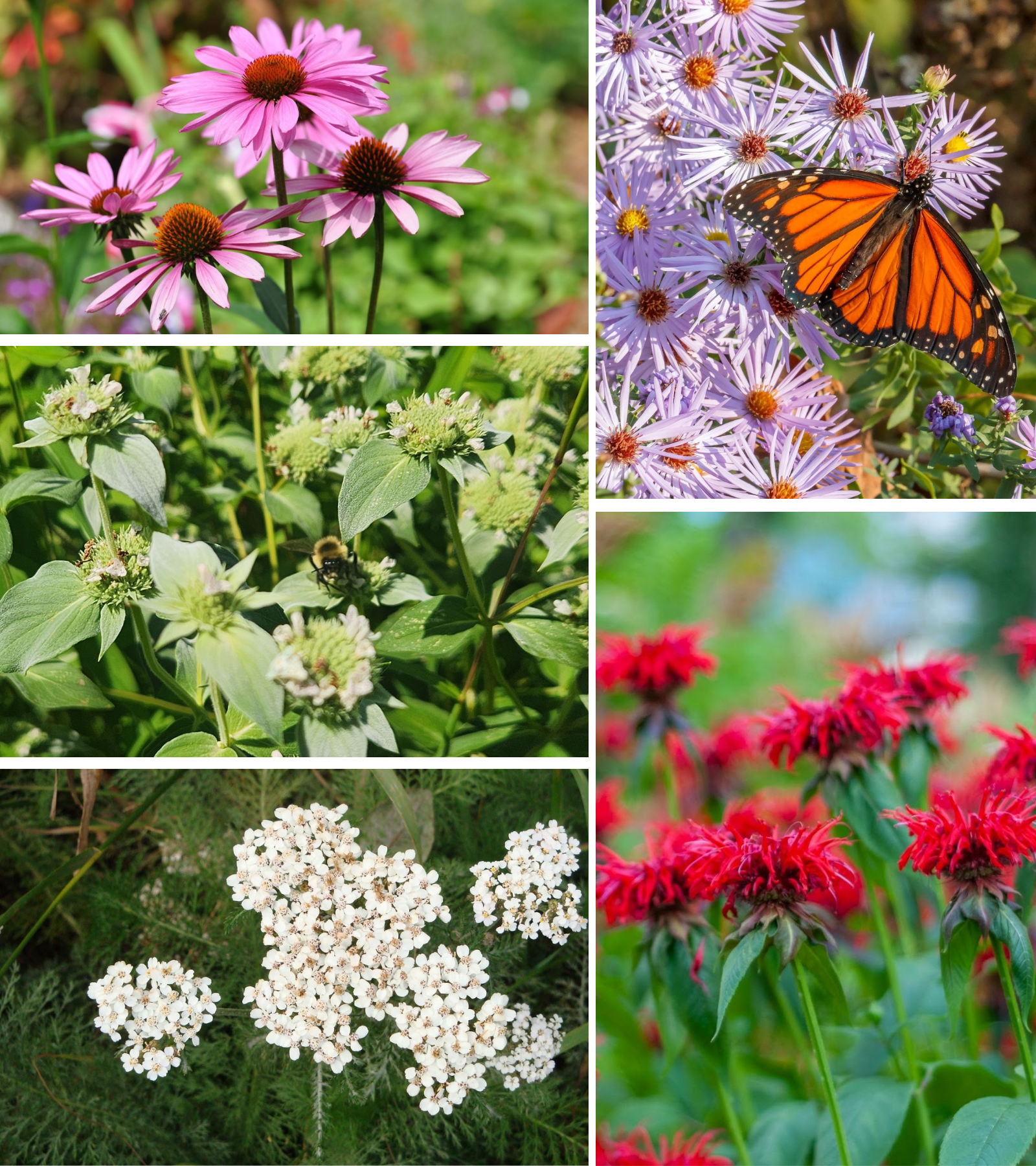
photo upper left: Sara “Asher” Morris, via Flickr, CC BY-NC 2.0; photo upper right: Tom Potterfield, via Flickr, CC BY-NC-SA 2.0; photo lower right: Blacklight O, via Flickr, CC BY-NC 2.0; photo lower left: Klondike Gold Rush NHP Alaska, via Flickr, CC BY-NC 2.0
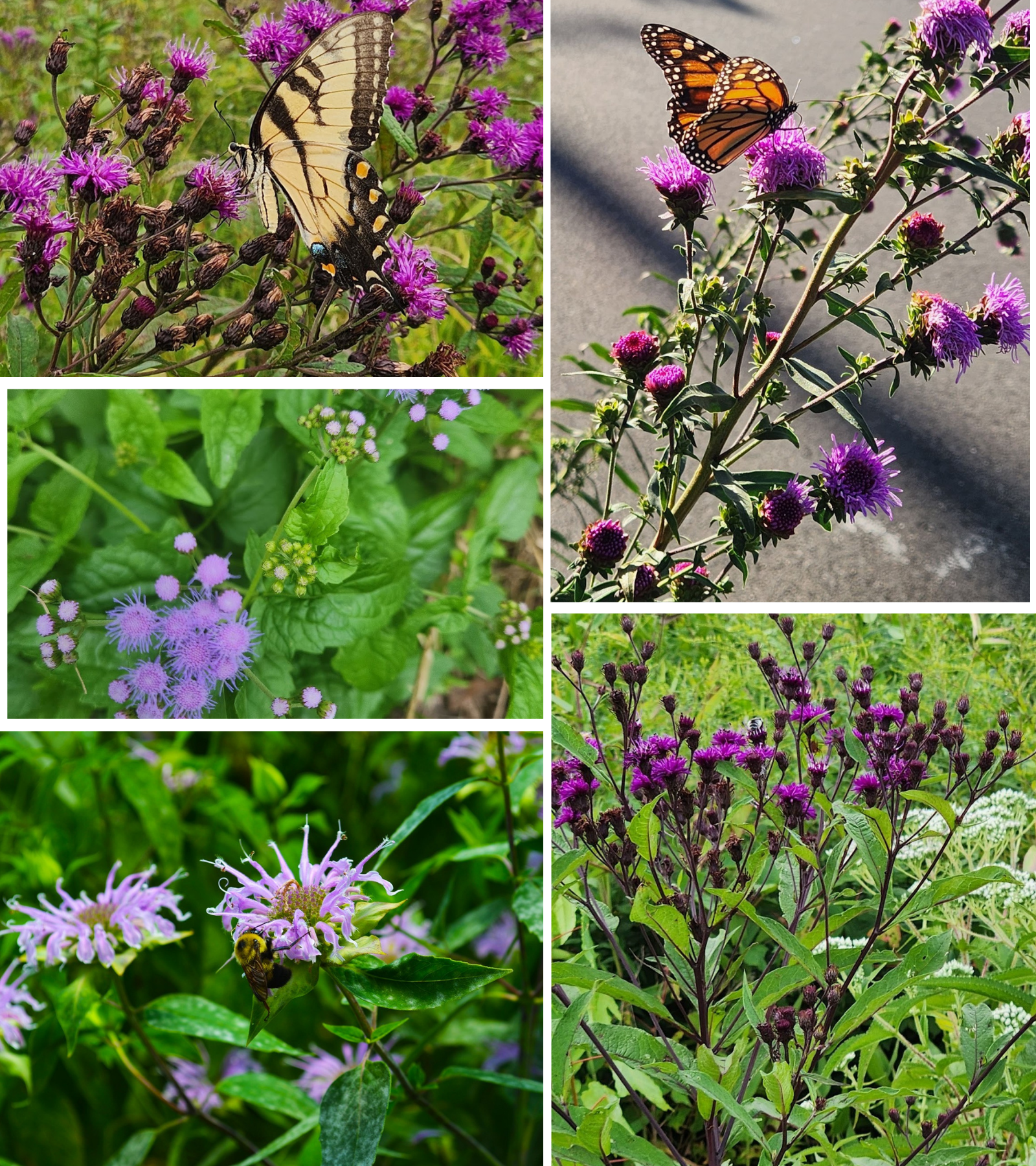
Combine bee balm (Monarda didyma), wild bergamot (Monarda fistulosa), blunt and hoary mountain mints (Pycnanthemum incanum and P. muticum), purple coneflower (Echinacea purpurea), blazing star (Liatris spicata), giant and NY ironweeds (Veronia gigantea and V. noveboracensis), common boneset, and mistflower (Conoclinium coelestinum), yarrow (Achillea millefolium), and aromatic aster (Symphyotrichum oblongifolium)
Beebalm, wild bergamot, and the mountain mints will spread out and fill large patches of your garden with brilliant red, purple, and white flowers respectively in July and August. Even better, those flowers attract a whole host of native pollinators such as hermit sphinx moth, orange mint moth, and the raspberry pyrausta. Interestingly, resin from beebalm has been used to treat bee stings, hence the origins of its name.
As a bonus, these four members of the mint family are all gross-tasting to deer and rabbits. This comes with two benefits: 1. That bad-taste for deer translates to a pleasant minty aroma and flavor for us humans. 2. You can use them to hide tastier flowers like purple coneflower from those voracious herbivores.
Purple coneflower gets points for its showy purple flowers, as well as for its herbal applications. Typically marketed by its scientific name, Echinacea, in tea blends, you can make your own blend at home, even combining it with some of the mints. Add yarrow to your garden for even more tea making options. Round out the herbal mix with some aromatic aster, which isn’t edible, but does smell very nice.
Once the mid-summer mints and coneflower fade, the ironweeds, bonesets and mistflowers take off. Both ironweed species, common boneset and mistflower, all have similar flower shapes, but at different heights and in complementary shades of purple and white which makes for an excellent combination. The ironweeds also offer dramatic dark purple stems, which both look cool and provide habitat for stem-nesting insects.
Of the bunch, giant ironweed gets the tallest (upwards of 12 ft), but New York ironweed isn’t far behind (8 ft), so keep that in mind when deciding where to place them. If you prefer shorter wildflowers, maybe swap in blazing star, which has a similar bloom color and timing. Plus, blazing star hosts two specialized moths: liatris flower moth and liatris borer moth!
Neaten up the edges with foxglove beardtongue and spiderworts! More on those species later.
Combo 2: Sunny Rain Gardens and Streambanks
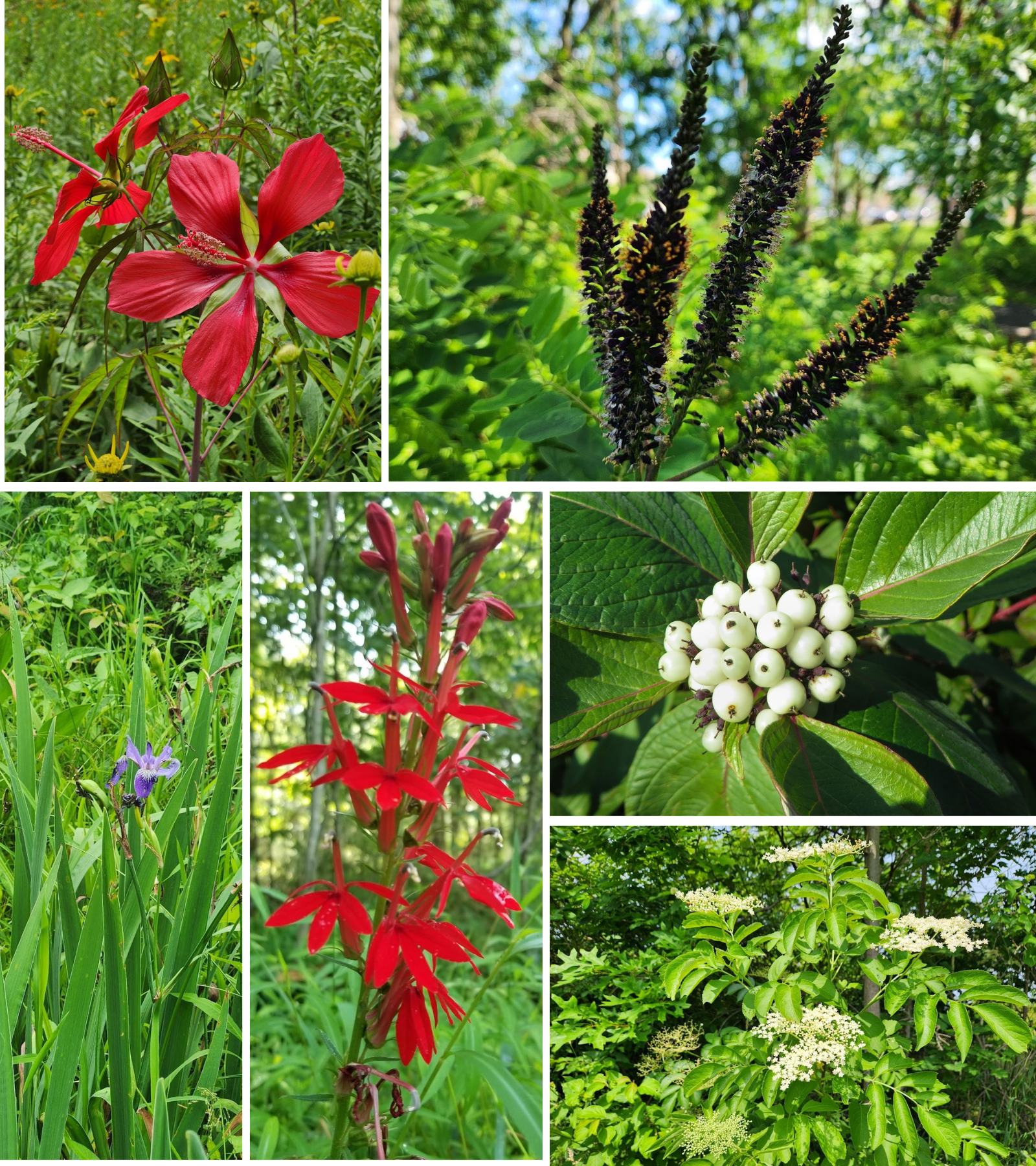
photo middle right: Monteregina (Nicole), via Flickr, CC BY-NC-SA 2.0
Combine blue flag iris (Iris versicolor), scarlet hibiscus (Hibiscus coccineus), red-twig dogwood (Cornus sericea), indigo bush (Amorpha fruticosa), and elderberry (Sambucus canadensis)
In this combo, red-twig dogwood will bloom first, and will potentially even bloom twice in a year. The flowers and subsequent berries are both white, but the stems provide a splash of red throughout the year. Lobelia cardinalis may be named after cardinals for their redness, but you are much more likely to see hummingbirds visiting these red flowers. Cardinal flower blooms from July through October. Scarlet rose mallow’s showy red flowers will join Cardinal flower in late summer and are visited by a specialized chimney bee (Ptilothrix bombiformis) among other native pollinators. Let the dead, hollow stems remain to provide shelter for stem-nesting bees.
Elderberry provides another wave of white flowers in late spring and early summer joined by blue flag iris and indigo bush. Those white flowers turn into delicious blue-black berries by the end of the summer. Jelly them, ferment them, bake them in a pie, whatever strikes your fancy, just be sure to cook them, as the raw and unripe berries can cause nausea. Or get your binoculars ready and use elderberry like a seasonal bird-feeder, as many species of songbird stop by for a sweet snack.
Flowers don’t get much darker than those of indigo bush. Practically black and tipped in purples and oranges, these flowers bloom at the same time as elderberry and blue flag iris, creating an excellent combination of flower shapes and hues of purple. Plus indigo bush also hosts silver-spotted skipper, gray hairstreak, and hoary edge skipper.
Combo 3: Shady Rain Gardens and Streambanks
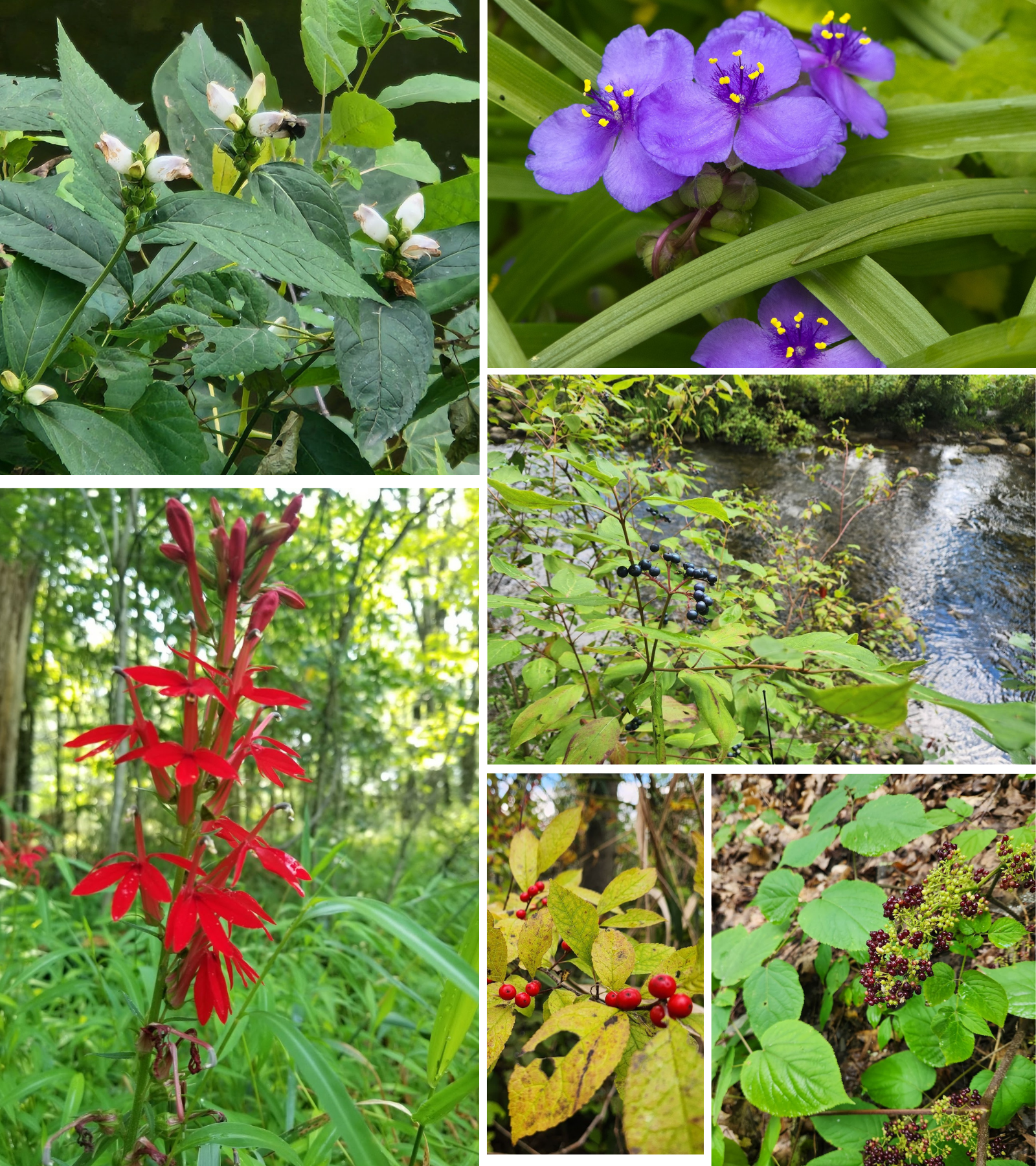
photo upper right: Steve 1828, via Flickr, CC BY-NC-ND 2.0
Combine cardinal flower (Lobelia cardinalis), Virginia spiderwort (Tradescantia virginiana), winterberry (Ilex verticillata), American spikenard (Aralia racemosa), turtlehead (Chelone glabra and C. lyonii), and silky dogwood (Cornus amomum).
This mix is abundant in cool shrubs from winterberry to another dogwood to American spikenard. Winterberry’s red doesn’t come in the form of flowers. Rather, it is the plant’s namesake berries that provide an awesome pop of red to your garden. Appearing in the autumn and often sticking around well into winter, winterberry’s berries are cool to see and even better for birds to eat.
To support and compliment the winterberry, adding silky dogwood will contribute even more winter-time red to your garden, plus beautiful white flowers in the spring. Silky dogwood is like red-twig dogwood in that it has reddish stems, but is more tolerant of shade than red-twig. Meanwhile, American spikenard comes in with pale summer-time clouds of flowers that turn into edible deep-red berries to add more range in color value to the garden. Spikenard tends to spread rhizomatically, meaning through its roots. Those roots have a spicy smell and flavor, and can be used to make root beer.
Throw in some cardinal flower again and some turtlehead and Virginia spiderwort to fill in around the shrubs. Turtlehead’s flowers are either white or pink depending on the species (C. glabra is white, C. lyonii is pink). They bloom in late summer and early fallproviding contrast in both shape and color to the more delicate red flowers of cardinal flower. The spiderwort blooms in May through July, filling the gap between the dogwood’s display and that of the cardinal flower and turtlehead.
Combo 4: Shade Garden
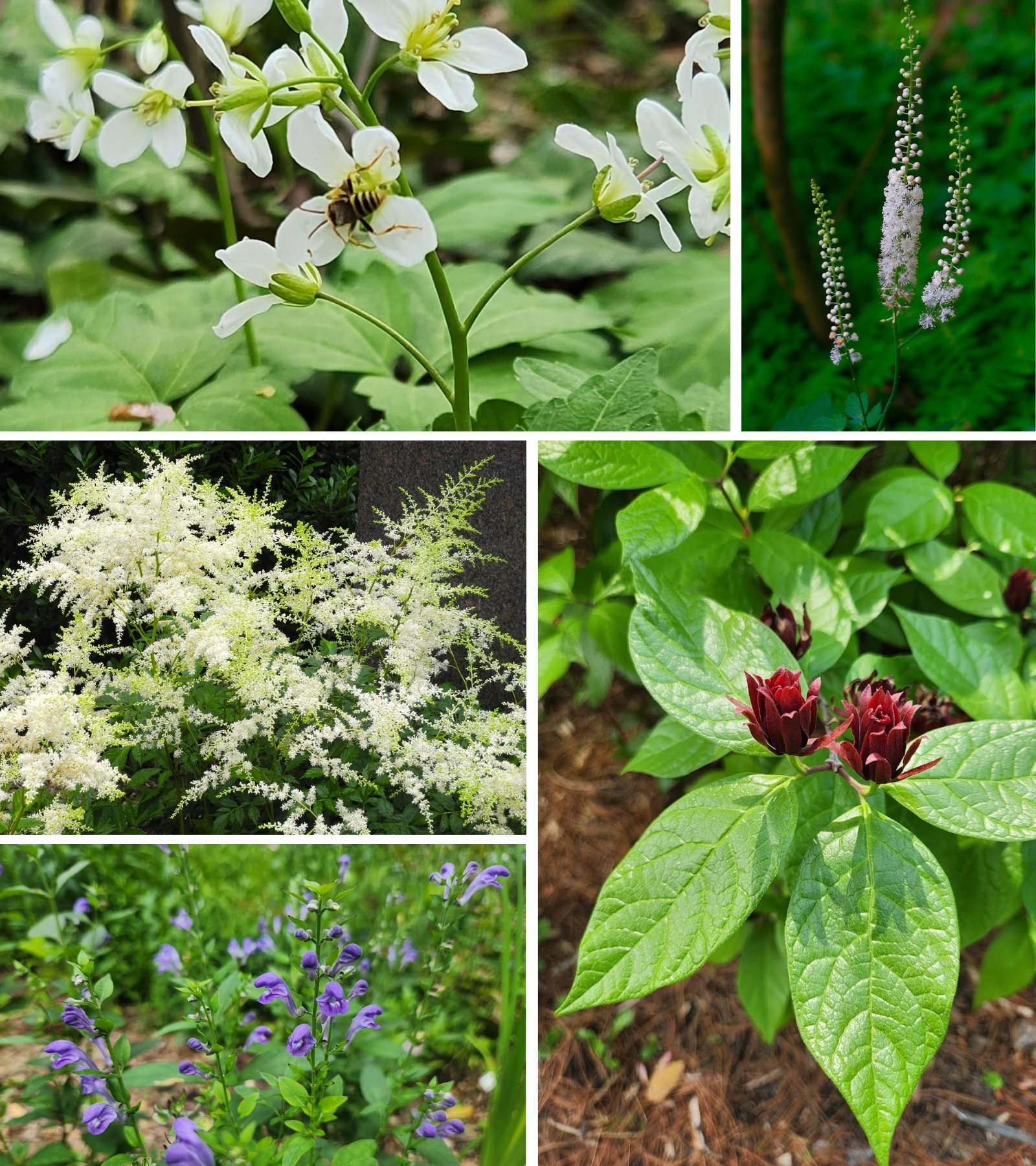
^photo upper right: Dan Mullen, via Flickr, CC BY-NC-ND 2.0; photo center left: Greg Maher, via NC State Extension Gardner Plant Tool Box, CC BY-NC 4.0
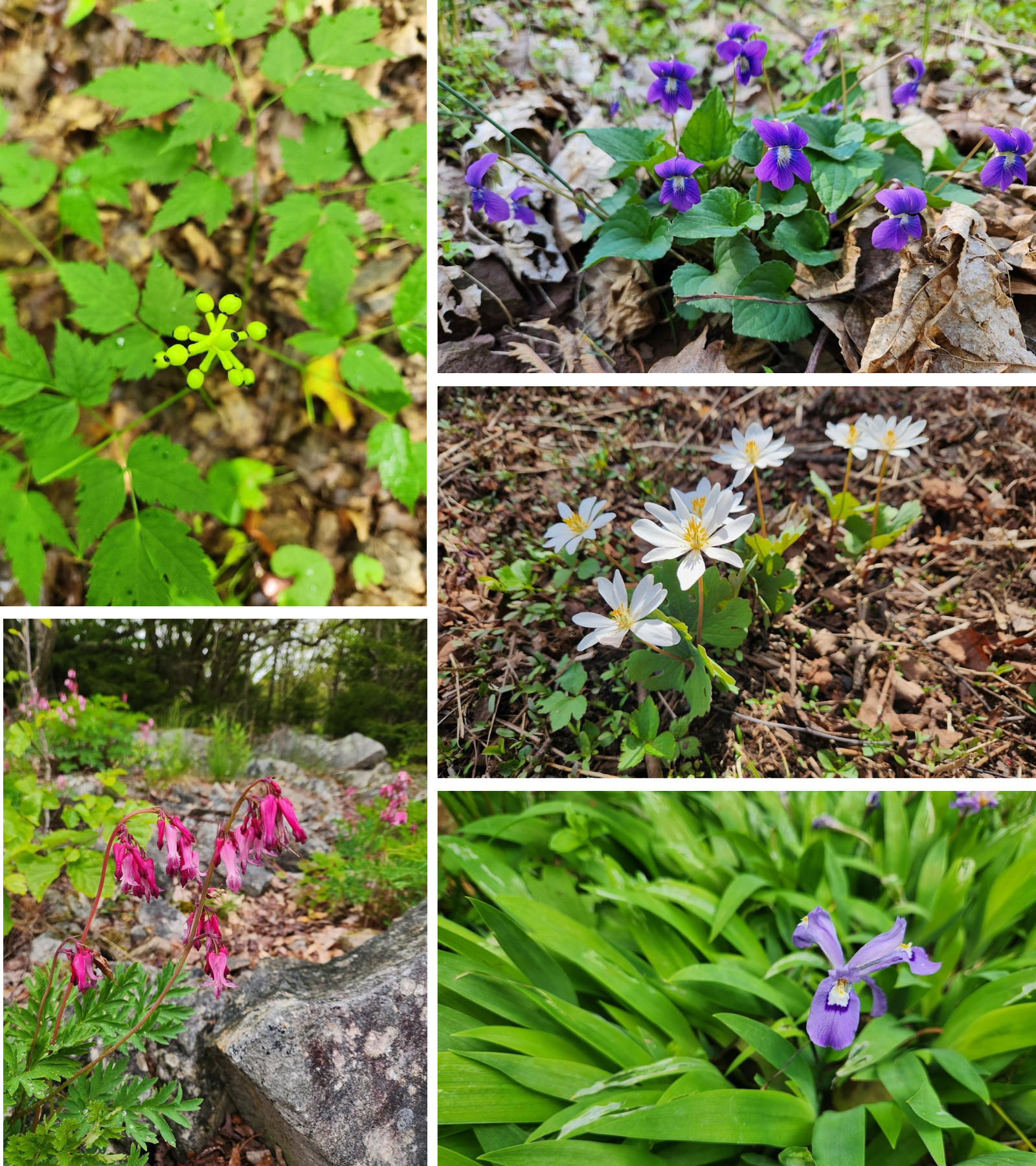
Combine bloodroot (Sanguinaria canadensis), fringed bleeding heart (Dicentra eximia), Carolina allspice (Calycanthus floridus), doll’s eyes and fairy candles (Actaea pachypoda and A. racemosa), downy skullcap (Scutellaria incana), false goat’s beard (Astilbe biternata), violets (Viola sororia), dwarf crested iris (Iris cristata), and two-leaf toothwort (Cardamine diphylla).
There are many on-theme options for the shadier spots in your garden. A wealth of purples from the downy skullcap, dwarf iris, and violets, is matched and surpassed by a variety of white flowers from the bloodroot, toothwort, doll’s eyes, fairy candles, and false goat’s beard. In this mix, downy skullcap, fairy candles, and violets are all important hosts for the caterpillars of a variety of moths and butterflies.
Bloodroot is a particularly unique specimen in this grouping, because it has a different lifestyle. Active in the early spring through early summer, bloodroot is known as a spring ephemeral, going dormant for the rest of the year. In that window of time, bloodroot plays several tricks on the insects that visit it. First, bloodroot’s flowers have all the appearances of a meal for our native pollinators, but when they show up, no nectar is to be found. Rather the insects leave covered in pollen with no sugary reward for their pollination service.
Once pollinated, bloodroot produces seeds that are covered in a substance called elaiosome, a sought-after food for ants. Hungry ants track down these seeds and take them back to their hill for later consumption. In doing so, the ants nicely bury the seeds which eventually germinate. This wild plant’s name comes from one more incredible physiological feature, the red sap that “bleeds” out if the roots are damaged. This red sap has been used as dyes and as insect repellant. That said, be careful if handling the roots because they are highly poisonous.
Fringed bleeding-heart and Carolina allspice provide a pop of red to this garden. Carolina allspice is a versatile shrub while also providing the kind of deep red needed for the desired vibe. The burgundy blooms appear in mid-April/May and will pop up occasionally in June and July. It can spread, so be prepared to either give it room or trim it back. As an added bonus, the leaves of Carolina allspice smell very good when crushed.
Combo 5: Sunnier Forest Edges and Garden Beds
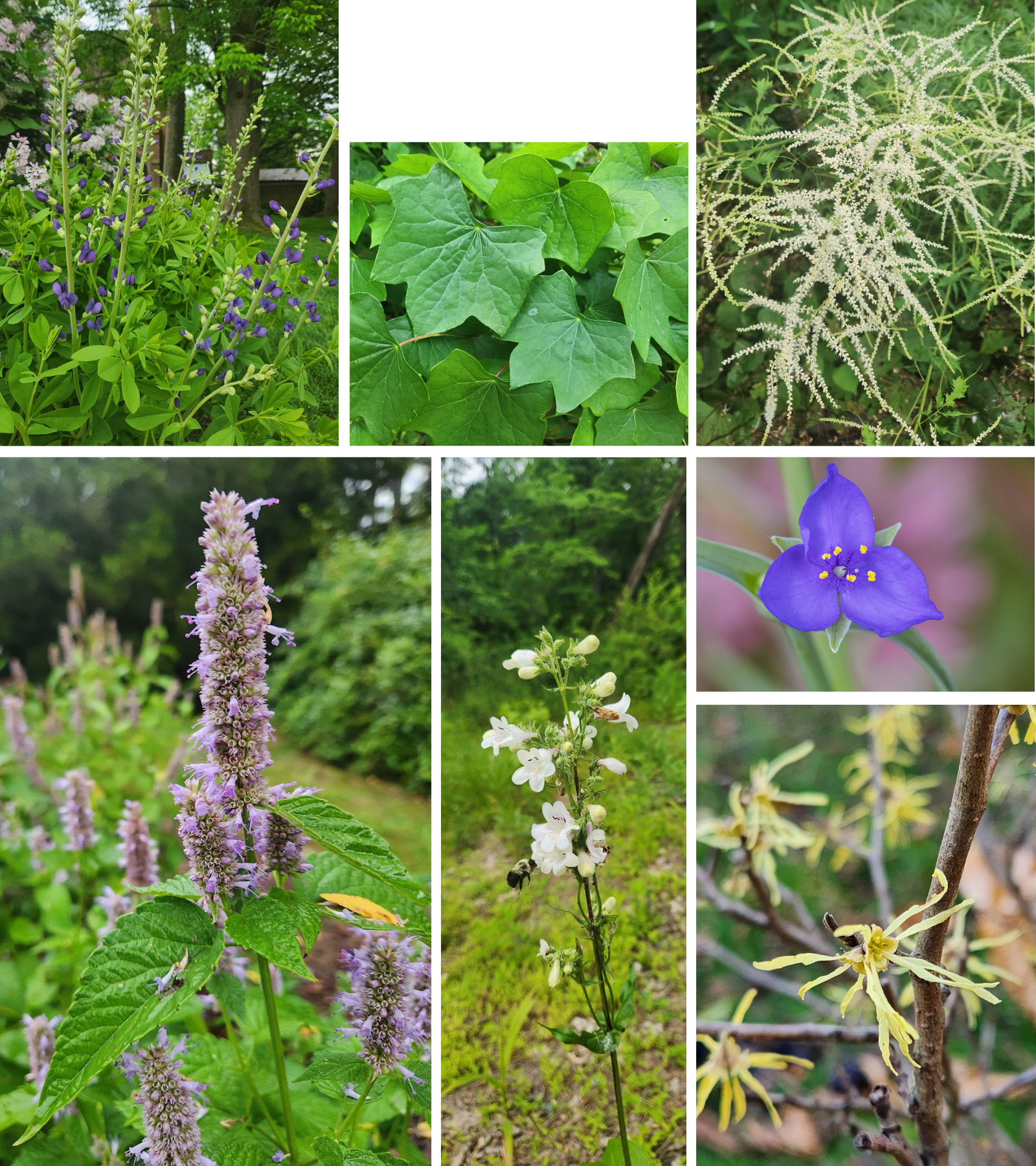
^photo right middle: Leslie~B, via Flickr, CC BY-NC-SA 2.0
Combine false blue indigo (Baptisia australis), witch hazel (Hamamelis virginiana), foxglove beardtongue (Penstemon digitalis), goat’s beard (Aruncus dioicus), Ohio spiderwort (Tradescantia ohiensis), moonseed (Menispermum canadense) and giant purple hyssop (Agastache scrophulariifolia).
This guide would certainly not be complete without a place for witch hazel. This versatile shrub has spindly, delicate yellow flowers that oddly show up late in October through December, after the leaves have fallen. These spider-like flowers are pollinated by a family of moth species commonly known as owlet moths.
While waiting for the witch hazel to bloom, foxglove beardtongue and goat’s beard fill May through July with white flowers while false blue indigo and Ohio spiderwort contribute purple ones. Of the bunch, false blue indigo is a particularly valuable host for butterflies, hosting the caterpillars of orange sulphur, clouded sulphur, frosted elfin, eastern tailed blue, hoary edge, and wild indigo duskywing.
The last member of this combo is moonseed, a vine that can also grow as a dense groundcover. Its common name refers to the single crescent-shaped seed found in each of the plant’s grape-like fruits. While this plant is poisonous if consumed by mammals, one species of moth has figured out how to get around the plant’s chemical defenses. The moonseed moth caterpillars are specialized for eating this vine. Interestingly, these caterpillars differ from most other species because they cut off the leaves and then eat them once they’re brown and dry.
Special Shout Out: Staghorn Sumac (Rhus typhina)
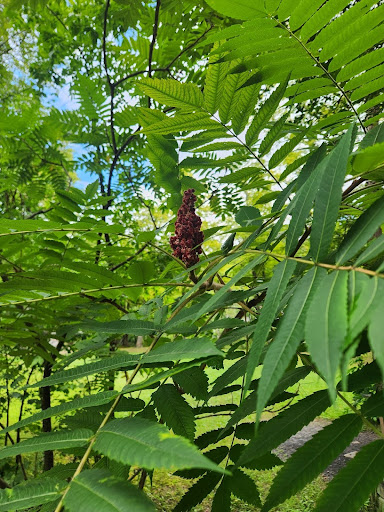
You’ve likely seen staghorn sumac before on roadside slopes, but its beautiful form and striking red fruits could earn it a place in your garden if you have the right spot for it. Staghorn sumac will spread somewhat aggressively so be prepared to give it room or trim it back. For your effort, staghorn sumac will attract a wide variety of birds, especially in the winter, who are looking to enjoy those striking fruits. People, too, can enjoy staghorn sumac’s fruits, often adding it to lemonade. As an added bonus, staghorn sumac is a host for the luna moth’s caterpillars.
Celebration of Autumn
Check out our Nature Note about which native trees and shrubs have the best fall foliage in order to maximize one of the best parts of the spookiest season.
Next Level: Carnivorous Plants
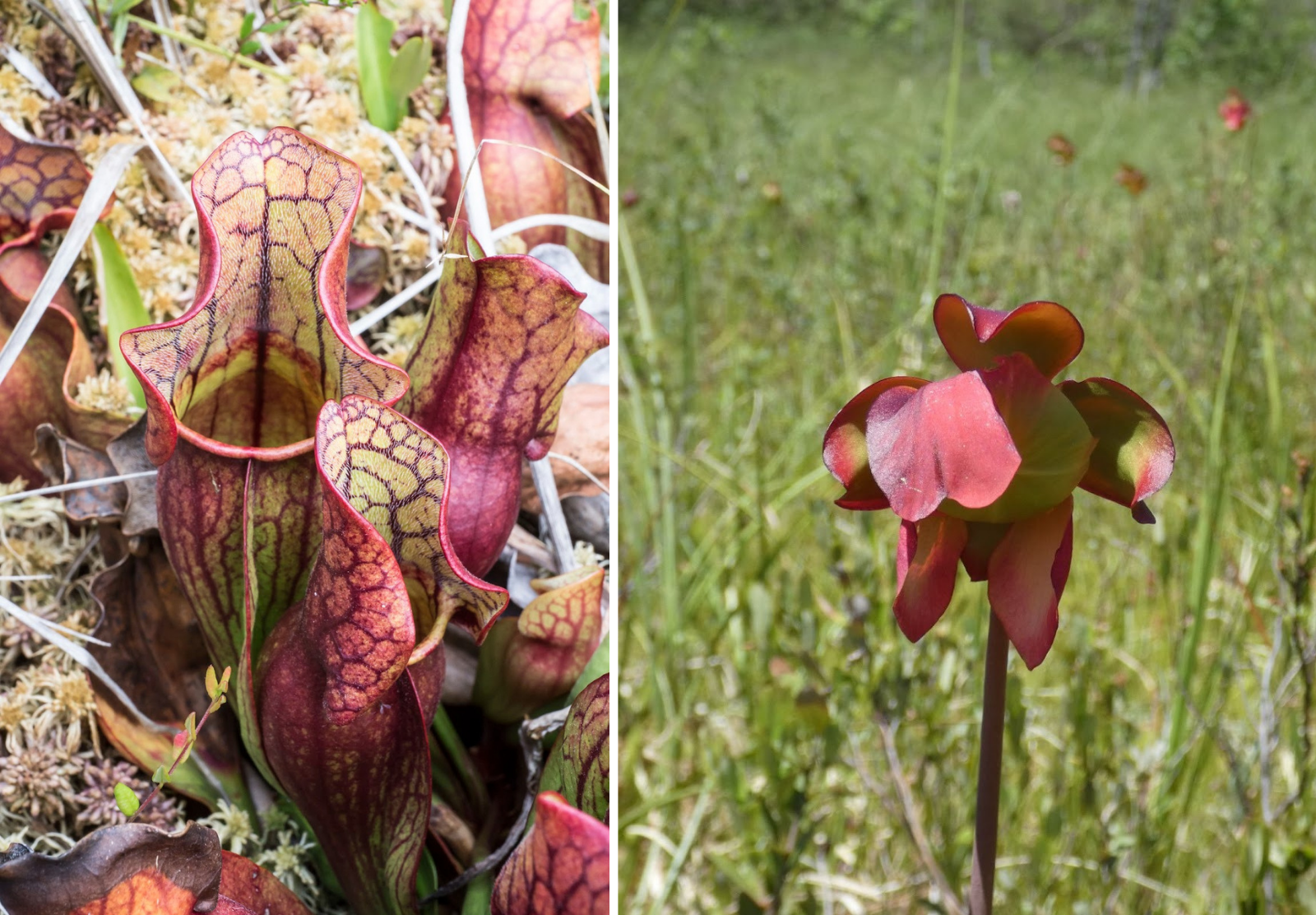
photo left: Tony Ernst, via Flickr, CC BY-NC-SA 2.0; photo right: Ann Fisher, via Flickr, CC BY-NC-ND 2.0
These recommendations too tame for you? Consider cultivating some of our native plants who don’t exactly behave like the rest of their kin.
Pitcher plants are a famous group of carnivorous plants, and we’re lucky enough to have a native species of our own, the purple pitcher plant (Sarracenia purpurea). Typically found in bogs, especially bogs with acidic, nitrogen-poor soils, this plant needs fairly extreme and specific growing conditions. The purple pitcher plant has experienced a great deal of habitat loss in recent decades. As such, never harvest these plants from the wild and be sure to find a reputable nursery to ensure that your cultivation of this fascinating plant doesn’t come at the expense of the species’s long-term survival.
Happy Gardening
Whether you recognize some of the plants in this guide as existing members of your garden and have found them new companions, or you are starting from scratch, I hope you have found some inspiration for the next stages of your garden.
May your garden be full of wildlife and your hands covered in dirt.
— Author Katie Toner is Heritage Conservancy’s Easement Stewardship Manager. All photos by Katie Toner unless otherwise noted, with thanks to the Creative Commons.
